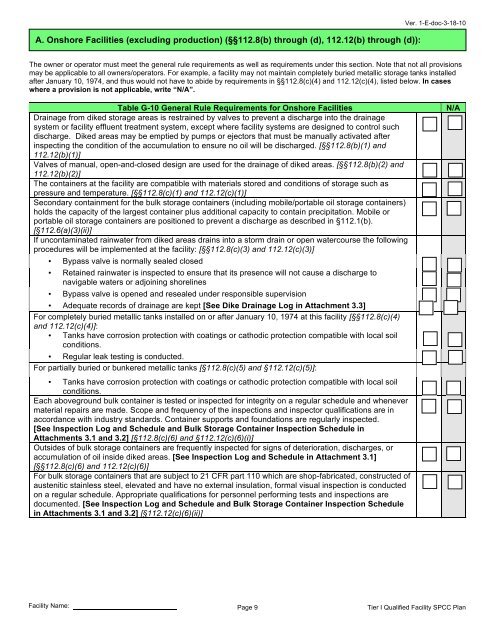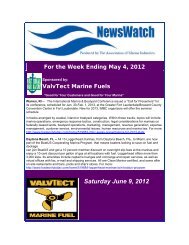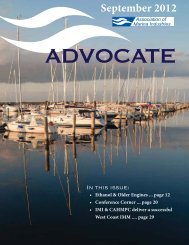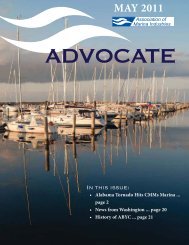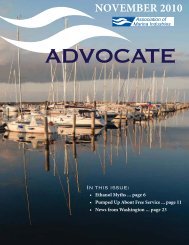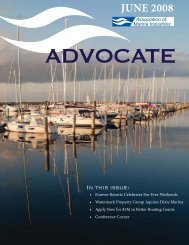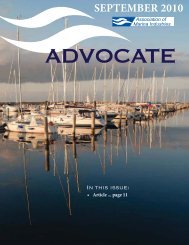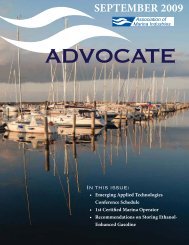Download a copy of AMI's Clean Marina best management practices ...
Download a copy of AMI's Clean Marina best management practices ...
Download a copy of AMI's Clean Marina best management practices ...
Create successful ePaper yourself
Turn your PDF publications into a flip-book with our unique Google optimized e-Paper software.
A. Onshore Facilities (excluding production) (§§112.8(b) through (d), 112.12(b) through (d)):<br />
Ver. 1-E-doc-3-18-10<br />
The owner or operator must meet the general rule requirements as well as requirements under this section. Note that not all provisions<br />
may be applicable to all owners/operators. For example, a facility may not maintain completely buried metallic storage tanks installed<br />
after January 10, 1974, and thus would not have to abide by requirements in §§112.8(c)(4) and 112.12(c)(4), listed below. In cases<br />
where a provision is not applicable, write “N/A”.<br />
Table G-10 General Rule Requirements for Onshore Facilities N/A<br />
Drainage from diked storage areas is restrained by valves to prevent a discharge into the drainage<br />
system or facility effluent treatment system, except where facility systems are designed to control such<br />
discharge. Diked areas may be emptied by pumps or ejectors that must be manually activated after<br />
inspecting the condition <strong>of</strong> the accumulation to ensure no oil will be discharged. [§§112.8(b)(1) and<br />
112.12(b)(1)]<br />
Valves <strong>of</strong> manual, open-and-closed design are used for the drainage <strong>of</strong> diked areas. [§§112.8(b)(2) and<br />
112.12(b)(2)]<br />
The containers at the facility are compatible with materials stored and conditions <strong>of</strong> storage such as<br />
pressure and temperature. [§§112.8(c)(1) and 112.12(c)(1)]<br />
Secondary containment for the bulk storage containers (including mobile/portable oil storage containers)<br />
holds the capacity <strong>of</strong> the largest container plus additional capacity to contain precipitation. Mobile or<br />
portable oil storage containers are positioned to prevent a discharge as described in §112.1(b).<br />
[§112.6(a)(3)(ii)]<br />
If uncontaminated rainwater from diked areas drains into a storm drain or open watercourse the following<br />
procedures will be implemented at the facility: [§§112.8(c)(3) and 112.12(c)(3)]<br />
• Bypass valve is normally sealed closed<br />
• Retained rainwater is inspected to ensure that its presence will not cause a discharge to<br />
navigable waters or adjoining shorelines<br />
• Bypass valve is opened and resealed under responsible supervision<br />
• Adequate records <strong>of</strong> drainage are kept [See Dike Drainage Log in Attachment 3.3]<br />
For completely buried metallic tanks installed on or after January 10, 1974 at this facility [§§112.8(c)(4)<br />
and 112.12(c)(4)]:<br />
• Tanks have corrosion protection with coatings or cathodic protection compatible with local soil<br />
conditions.<br />
• Regular leak testing is conducted.<br />
For partially buried or bunkered metallic tanks [§112.8(c)(5) and §112.12(c)(5)]:<br />
• Tanks have corrosion protection with coatings or cathodic protection compatible with local soil<br />
conditions.<br />
Each aboveground bulk container is tested or inspected for integrity on a regular schedule and whenever<br />
material repairs are made. Scope and frequency <strong>of</strong> the inspections and inspector qualifications are in<br />
accordance with industry standards. Container supports and foundations are regularly inspected.<br />
[See Inspection Log and Schedule and Bulk Storage Container Inspection Schedule in<br />
Attachments 3.1 and 3.2] [§112.8(c)(6) and §112.12(c)(6)(i)]<br />
Outsides <strong>of</strong> bulk storage containers are frequently inspected for signs <strong>of</strong> deterioration, discharges, or<br />
accumulation <strong>of</strong> oil inside diked areas. [See Inspection Log and Schedule in Attachment 3.1]<br />
[§§112.8(c)(6) and 112.12(c)(6)]<br />
For bulk storage containers that are subject to 21 CFR part 110 which are shop-fabricated, constructed <strong>of</strong><br />
austenitic stainless steel, elevated and have no external insulation, formal visual inspection is conducted<br />
on a regular schedule. Appropriate qualifications for personnel performing tests and inspections are<br />
documented. [See Inspection Log and Schedule and Bulk Storage Container Inspection Schedule<br />
in Attachments 3.1 and 3.2] [§112.12(c)(6)(ii)]<br />
Facility Name:<br />
Page 9 Tier I Qualified Facility SPCC Plan


